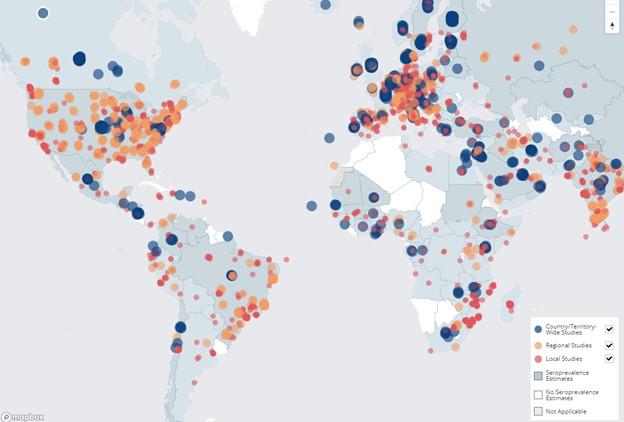Jan. 20, 2023
UCalgary and WHO researchers find hybrid immunity is the best protection against COVID-19

A University of Calgary research group that includes several Bachelor of Health Sciences alumni joined forces with members of the World Health Organization (WHO) to tackle a global health question: What is the best protection against COVID-19?
Analyzing data from controlled studies throughout the world, researchers discovered people with hybrid immunity are the most protected against severe illness and reinfection. Hybrid immunity occurs when someone has had at least the full series of vaccines and has also had a prior infection, in any order. The study, published in The Lancet Infectious Diseases, helps public policy-makers understand the optimal timing of vaccinations.

Niklas Bobrovitz, first author, is a UCalgary alumni, and a medical student at the University of Toronto.
“The results reinforce the global imperative for vaccination,” says Dr. Niklas Bobrovitz, DPhil, BHSc’11, MSc’14, and first author on the study. “A common question throughout the pandemic was whether previously infected people should also get vaccinated. Our results clearly indicate the need for vaccination, even among people that have had COVID-19.”
The global emergence and rapid spread of the Omicron variant of concern required scientists and policy-makers to reassess population protection against Omicron infection and severe disease. In the study, investigators were able to look at immune protection against Omicron after a prior SARS-CoV-2 infection (the virus that causes COVID-19), vaccination or hybrid immunity.
“Protection against hospitalization and severe disease remained above 95 per cent for 12 months for individuals with hybrid immunity,” says Dr. Lorenzo Subissi, PhD, a technical officer with WHO and senior author on the study. “We know more variants are going to emerge. The study shows, to reduce infection waves, vaccinations could be timed for rollout just prior to expected periods of higher infection spread, such as the winter season.”

Lorenzo Subissi, senior author on the study, is a scientist with the World Health Organization.
The systematic review and meta-analysis found that protection against Omicron infection declines substantially by 12 months, regardless of whether you’ve had an infection, vaccinations or both, which means vaccination is the best way to periodically boost your protection and to keep down levels of infection in the population. In total, 4,268 articles were screened and 895 underwent full-text review — a difficult task before the assistance of experts in health informatics.
“This study demonstrates the power of machine translation. We were able to break through language barriers; most of the time, systematic reviews aren’t done in every language, they are limited to one or two,” says Dr. Tyler Williamson, BSc'05, PhD'11, director of the Centre for Health Informatics at the Cumming School of Medicine. “These former BHSc classmates, along with the large diverse team they brought together, have emerged as global leaders in SARS-CoV-2 research and delivered decision-grade evidence to the world.”
While the findings demonstrate that vaccination along with a prior infection carries the most protection, the scientists warn against intentional exposure to the virus.
“You should never try to get COVID-19,” says Bobrovitz. “The virus is unpredictable in how it will affect your system. For some, it can be fatal or send you to hospital. Even if you have a mild infection, you risk developing long COVID.”
The group says the next phase of this research would be to investigate how the bivalent vaccine performs against severe disease.
The study is supported by the WHO COVID-19 Solidarity Response Fund and the Coalition for Epidemic Preparedness Innovation (CEPI). The views reported do not necessarily reflect the official position of WHO or CEPI.
Findings from the study compliment data on the SeroTracker dashboard which monitors studies and news reports to track seroprevalence data – the percentage of people in a population who have antibodies against the novel coronavirus. The website aggregates serology data from studies and news reports in different populations, and built-in filters allow users to compare seroprevalence levels between countries, occupations, and demographic groups.
Other contributors to the paper are Harriet Ware, Xiaomeng Ma, Zihan Li, Reza Hosseini, Christian Cao, Anabel Selemon, Mairead Whelan, Zahra Premji, Hanane Issa, Brianna Cheng, Laith J. Abu Raddad, David Buckeridge, Maria Van Kerkhove, Vanessa Piechotta, Melissa Higdon, Annelies Wilder-Smith, Isabel Bergeri, Daniel Feikin, Rahul Arora and Minal Patel representing universities and institutions in the U.S., United Kingdom, Qatar, Switzerland Germany, and Canada.
Niklas Bobrovitz, DPhil, BHSc ’11, MSc’14, is a final-year medical student at the University of Toronto and research associate at the University of Calgary.
Tyler Williamson, PhD, is an associate professor in the Department of Community Health Sciences at the Cumming School of Medicine (CSM). He is the director of the Centre for Health Informatics and a member of the O’Brien Institute for Public Health and the Alberta Children’s Hospital Research Institute at the CSM.








